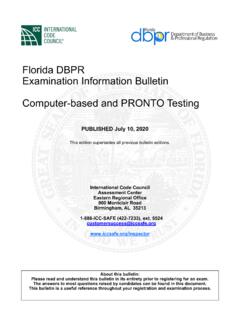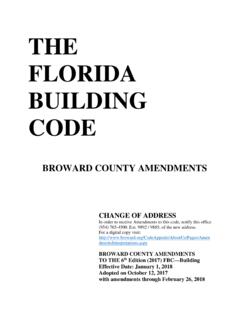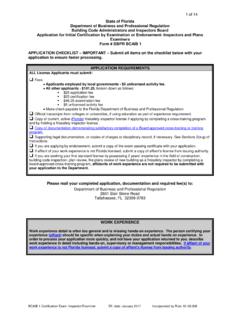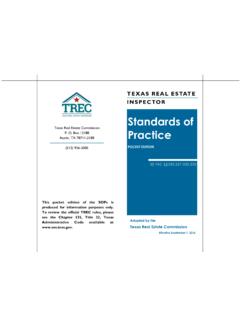Transcription of Vermont Residential Building Standards (RBES) Energy Code ...
1 Energy Code Assistance Center855-887-0673 ~ toll free Vermont Public Service Department Efficiency & Energy Resources Division112 State StreetMontpelier, VT 05620-2601802-828-2811 Vermont Residential Building Standards (RBES) Energy Code HandbookA Guide to Complying withVermont s Residential Building Energy Standards (30 51)FIFTH EDITIONBase & Stretch Energy Code Effective September 1, 2020 The Vermont Residential Building Energy StandardsThis publication was prepared with the support of the Department of How to Use This Handbook ..1 When to Consult the Handbook ..1 What s New in RBES 2020? ..1If You Need Help ..2 Introduction: The Vermont Residential Standards (RBES) Energy Code ..4 What Buildings Must Comply? ..4 What Buildings Are Exempt? ..4 The Basic Steps for Meeting the Energy Code ..5 Compliance Methods ..5 Stretch ..6 Technical Assistance with Energy Code Requirements ..6 Residential Energy Code Updates.
2 6 Chapter 1: Rules for Compliance .. Builder s Responsibilities .. Buildings That Must Comply .. Exempt Buildings .. Owner/Builder Special Provision .. Act 250 Provisions .. Penalty for Not Complying with the Residential Energy Code ..10 Chapter 2: Basic Requirements .. Building Envelope .. Vapor Retarders .. Materials and Equipment Heating and Cooling .. Service (Potable) Water Heating .. 3 : Ventilation and Combustion Safety Requirements .. Ventilation .. Combustion Safety ..40 Chapter 4 : Existing Homes: Additions, Alterations, and Repairs .. Compliance ..45 Prescriptive Compliance for Additions .. U-Factor Alternative Compliance for Additions ..47 Chapter 5 : The Package-Plus-Points Prescriptive Compliance Method .. When to Use the Packages-Plus-Points Method .. Meeting BASE Code Using the Packages-Plus-Points Method .. Meeting STRETCH Code Using the Packages-Plus-Points Method.
3 Building assembly and window examples ..53 Chapter 6 : The REScheck Software Compliance Method .. How the Software Method Works .. Using REScheck Software .. How to Access the REScheck Software ..66 Chapter 7 : The Home Energy Rating Compliance Method .. How the Home Energy Rating Method Works .. Advantages of the Home Energy Rating Method .. The Home Energy Rating .. Minimum Thermal Envelope Efficiency Levels for HERS HERS Compliance Process ..72 Chapter 8 : Certification .. Types of Certification .. The Vermont Residential Building Energy Standards Certificate .. The Vermont Owner/Builder Disclosure Statement ..78 Appendix A: Additional Stretch Code Requirements .. Package Plus Points .. Home Energy Rating Compliance Method .. Air Leakage Testing .. Electric Vehicle (EV) Charging .. Solar Ready .. Construction Document Requirements for Solar Ready Zone .. Solar-Ready Zone.
4 Roof Load Documentation.. Interconnection Pathway.. Electrical Service Reserved Space..84 Appendix B: Default Values ..85 Appendix C: Guidelines for Calculations .. When to Perform Calculations .. How to Define the Building Envelope .. How to Calculate the Glazing Percentage .. Understanding Thermal Values .. How to Calculate Average R-values and U-factors .. Average U-factors ..91 Appendix D: Vermont Resources for Energy Efficiency & Utility Services ..93 Appendix E: Residential Building Energy Standards Legislation ..96 Appendix F: Edition September 2020 How to Use This HandbookThis Handbook contains information explaining the key requirements of Vermont s Residential Building Energy Standards ( RBES or the Energy Code ) for Residential construction. Each chapter is divided into sections. For instance, a reference to Section indicates the third section of Chapter 2. Further divisions of a section are labeled with a letter ( , , , etc.)
5 Tables and figures are numbered sequentially within each chapter. For example, the first table in Chapter 3 is Table 3-1, the second table is Table 3-2, Handbook also includes references to sections in the RBES code language. Visit for a free viewable copy of the full printed copy can be obtained by calling the Energy Code Assistance Center at 855-887-0673, toll free. When to Consult the HandbookThere are four main situations that call for a review of this Handbook:1. When making additions, alterations, renovations or repairs to existing During the new construction design stage, review the requirements up front. It will be easier and less expensive at this stage to make any modifications needed to ensure In the event of new construction design changes, review whether the home still complies when there are changes. This will ensure that there are no surprises upon Upon completion, State law requires every Vermont builder to certify that the home complies with the Energy Code as built, altered or repaired.
6 The Vermont Residential Building Energy StandardsWhat s Newin RBES2020?Major changes from RBES 2015 include but are not limited to: 1. Clarification of definitions and other language2. Insulation and fenestration criteria Base Code: Prescriptive packages plus required points from a list of options based on the house size Stretch Code: Similar package plus points approach as base code, but with more stringent prescriptive packages and more points required3. Air Leakage Testing Blower door testing by a certified tester is now required for both Base and Stretch Code4. Electric resistance heating equipment is prohibited except under certain stringent conditions5. Electric vehicle charging (Base & Stretch) minimum charging infrastructure now required6. HERS rating values include an adjustment factor that accounts for Building size and shape in the calculation (Base & Stretch)7. Solar Ready required for Stretch Code Introduction: Vermont Residential Building Energy Standards summarizes the key features of the Energy Code.
7 Chapter 1: Rules for Compliance explains in detail which buildings must comply and which are exempt. Chapter 2: Basic Requirements explains in detail the mandatory requirements that all buildings must meet (aside from additional Prescriptive or Performance requirements). Chapter 3: Ventilation and Combustion Safety Requirements discusses the importance of indoor air quality and how to achieve it. Chapter 4: Existing Homes: Additions, Alterations, and Repairs explains requirements for additions, alterations and repairs. Chapter 5: The Package Plus Points Compliance Method explains how to meet the Energy Code via the Package Plus Points compliance pathway. This method is similar to the Prescriptive Compliance Method from previous code cycles but with key changes. Chapter 6: The REScheck Software Compliance Method explains how REScheck can be used to check for compliance. Chapter 7: The Home Energy Rating Compliance Method explains how Energy Rating Index or Home Energy Rating System ( ERI or HERS ) can be used for compliance.
8 Chapter 8: Certification specifies how to accurately certify compliance with the Energy Appendices include the minimum requirements for Stretch code, definitions and clarifications of terms used in this Handbook, default R-values and U-factors, guidelines for calculations, and Vermont -specific resources for You Need HelpThe Energy Code Assistance Center (ECAC) provides free technical assistance. Call toll-free: Edition September 2020 The Vermont Residential Building Energy StandardsIntroduction: The Vermont Residential Energy Code 3 The Vermont Residential Building Energy Standards ( RBES , the Residential Energy Code or simply the Energy Code ) initially was passed by the Vermont legislature in May 1997. It is a minimum standard of Energy efficiency that has applied to virtually all new Residential construction in Vermont since July 1, 1998 with updates in 2006, 2011, 2015, and 2020. The 2020 Energy Code is based on the 2015 Vermont Residential Building Energy Standards , which are based on the International Energy Conservation Code (IECC).
9 The 2020 RBES also includes select IECC 2018 and 2021 updates with additionally stringent Vermont Energy efficiency Buildings Must Comply? Detached one- and two-family dwellings. Multi-family and all other Residential dwellings three stories or fewer in height. Additions, alterations, renovations and repairs to existing Residential buildings. Factory-built modular homes not on a permanent chassis. Residential buildings commencing construction on or after September 1, 2020 must comply with this Energy Code. Residential buildings for which construction commenced before September 1, 2020, if not complying with this Code, must comply with the previous version of RBES. Act 250 projects commencing construction on or after September 1, 2020 must comply with the 2020 Stretch Code. In towns that require a certificate of occupancy (COO), a RBES certificate is required before the COO can be is a summary; see Chapter 1 for Buildings Are Exempt?
10 Commercial and high-rise Residential buildings (over three stories); however, these must meet the Commercial Building Energy Standards ( CBES ). Residential portions of a mixed-use Building that is three stories or less must meet the Residential Energy Code. Residential portions of mixed-use buildings include the living spaces in the Building and the nonliving spaces in the Building that serve only the Residential users such as common hallways, laundry facilities, Residential management offices, community rooms, storage rooms, and foyers. Mobile homes on a permanent chassis (except for site-built components such as conditioned basements or crawl spaces). Buildings or additions with very low Energy use (those designed for a peak Energy use of less than Btu/hr. [1 Watt] per square foot of floor area). Unconditioned buildings. Hunting camps or summer camps. Note that summer camps are only exempt if constructed for non-winter occupation with only a biomass (wood) or other on-site renewable heating system.
![CHAPTER 1 [RE] SCOPE AND ADMINISTRATION](/cache/preview/1/1/f/7/4/3/f/a/thumb-11f743fa14bc84f2623f838c451f736f.jpg)






